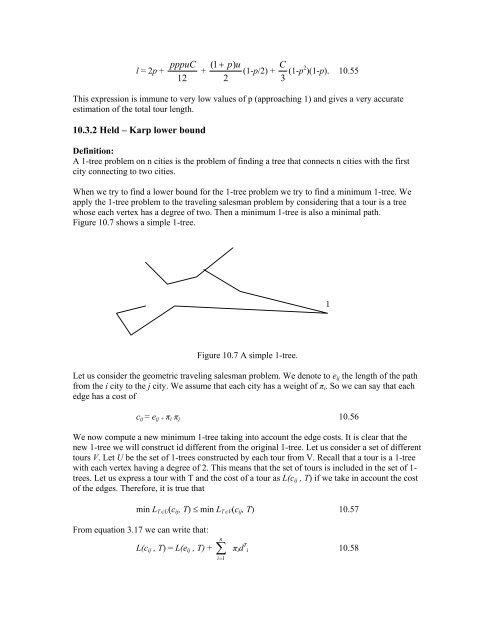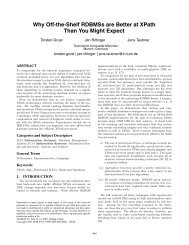Chapter 10 The Traveling Salesman Problem
Chapter 10 The Traveling Salesman Problem
Chapter 10 The Traveling Salesman Problem
Create successful ePaper yourself
Turn your PDF publications into a flip-book with our unique Google optimized e-Paper software.
l = 2p +<br />
pppuC<br />
+<br />
12<br />
( 1+<br />
p)<br />
u<br />
2<br />
C 2<br />
(1-p/2) + (1-p )(1-p). <strong>10</strong>.55<br />
3<br />
This expression is immune to very low values of p (approaching 1) and gives a very accurate<br />
estimation of the total tour length.<br />
<strong>10</strong>.3.2 Held – Karp lower bound<br />
Definition:<br />
A 1-tree problem on n cities is the problem of finding a tree that connects n cities with the first<br />
city connecting to two cities.<br />
When we try to find a lower bound for the 1-tree problem we try to find a minimum 1-tree. We<br />
apply the 1-tree problem to the traveling salesman problem by considering that a tour is a tree<br />
whose each vertex has a degree of two. <strong>The</strong>n a minimum 1-tree is also a minimal path.<br />
Figure <strong>10</strong>.7 shows a simple 1-tree.<br />
Figure <strong>10</strong>.7 A simple 1-tree.<br />
Let us consider the geometric traveling salesman problem. We denote to eij the length of the path<br />
from the i city to the j city. We assume that each city has a weight of πi. So we can say that each<br />
edge has a cost of<br />
cij = eij + πi πj<br />
1<br />
<strong>10</strong>.56<br />
We now compute a new minimum 1-tree taking into account the edge costs. It is clear that the<br />
new 1-tree we will construct id different from the original 1-tree. Let us consider a set of different<br />
tours V. Let U be the set of 1-trees constructed by each tour from V. Recall that a tour is a 1-tree<br />
with each vertex having a degree of 2. This means that the set of tours is included in the set of 1trees.<br />
Let us express a tour with T and the cost of a tour as L(cij , T) if we take in account the cost<br />
of the edges. <strong>The</strong>refore, it is true that<br />
min LT∈U(cij, T) ≤ min LT∈V(cij, T) <strong>10</strong>.57<br />
From equation 3.17 we can write that:<br />
L(cij , T) = L(eij , T) + ∑ π<br />
n<br />
i= 1<br />
id T i<br />
<strong>10</strong>.58






